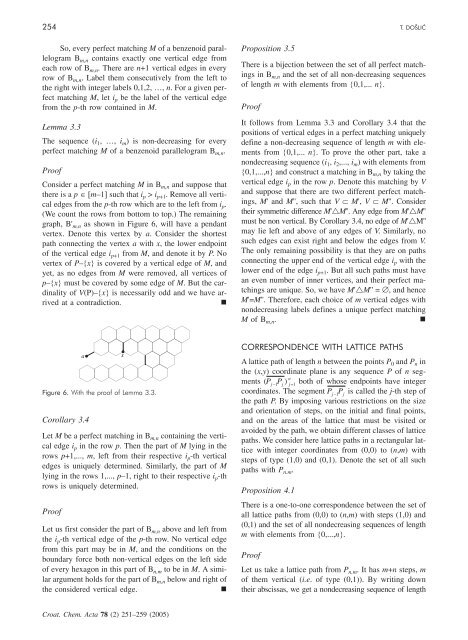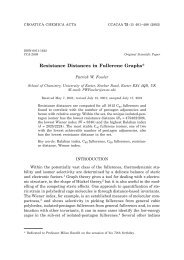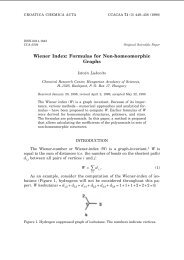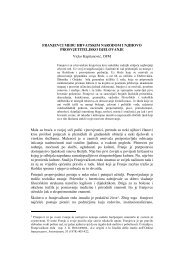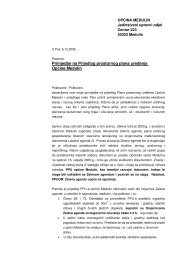Perfect Matchings in Lattice Animals and Lattice Paths with Constraints
Perfect Matchings in Lattice Animals and Lattice Paths with Constraints
Perfect Matchings in Lattice Animals and Lattice Paths with Constraints
- No tags were found...
You also want an ePaper? Increase the reach of your titles
YUMPU automatically turns print PDFs into web optimized ePapers that Google loves.
254 T. DO[LI]<br />
So, every perfect match<strong>in</strong>g M of a benzenoid parallelogram<br />
B m,n conta<strong>in</strong>s exactly one vertical edge from<br />
each row of B m,n . There are n+1 vertical edges <strong>in</strong> every<br />
row of B m,n . Label them consecutively from the left to<br />
the right <strong>with</strong> <strong>in</strong>teger labels 0,1,2, …, n. For a given perfect<br />
match<strong>in</strong>g M, let i p be the label of the vertical edge<br />
from the p-th row conta<strong>in</strong>ed <strong>in</strong> M.<br />
Lemma 3.3<br />
The sequence (i 1 ,…,i m ) is non-decreas<strong>in</strong>g for every<br />
perfect match<strong>in</strong>g M of a benzenoid parallelogram B m,n .<br />
Proof<br />
Consider a perfect match<strong>in</strong>g M <strong>in</strong> B m,n <strong>and</strong> suppose that<br />
there is a p m–1 such that i p > i p+1 . Remove all vertical<br />
edges from the p-th row which are to the left from i p .<br />
(We count the rows from bottom to top.) The rema<strong>in</strong><strong>in</strong>g<br />
graph, B' m,n as shown <strong>in</strong> Figure 6, will have a pendant<br />
vertex. Denote this vertex by a. Consider the shortest<br />
path connect<strong>in</strong>g the vertex a <strong>with</strong> x, the lower endpo<strong>in</strong>t<br />
of the vertical edge i p+1 from M, <strong>and</strong> denote it by P. No<br />
vertex of P–x is covered by a vertical edge of M, <strong>and</strong><br />
yet, as no edges from M were removed, all vertices of<br />
p–x must be covered by some edge of M. But the card<strong>in</strong>ality<br />
of V(P)–x is necessarily odd <strong>and</strong> we have arrived<br />
at a contradiction.<br />
<br />
Proposition 3.5<br />
There is a bijection between the set of all perfect match<strong>in</strong>gs<br />
<strong>in</strong> B m,n <strong>and</strong> the set of all non-decreas<strong>in</strong>g sequences<br />
of length m <strong>with</strong> elements from 0,1,... n.<br />
Proof<br />
It follows from Lemma 3.3 <strong>and</strong> Corollary 3.4 that the<br />
positions of vertical edges <strong>in</strong> a perfect match<strong>in</strong>g uniquely<br />
def<strong>in</strong>e a non-decreas<strong>in</strong>g sequence of length m <strong>with</strong> elements<br />
from 0,1,... n. To prove the other part, take a<br />
nondecreas<strong>in</strong>g sequence (i 1 , i 2 ,..., i m ) <strong>with</strong> elements from<br />
0,1,...,n <strong>and</strong> construct a match<strong>in</strong>g <strong>in</strong> B m,n by tak<strong>in</strong>g the<br />
vertical edge i p <strong>in</strong> the row p. Denote this match<strong>in</strong>g by V<br />
<strong>and</strong> suppose that there are two different perfect match<strong>in</strong>gs,<br />
M' <strong>and</strong> M'', such that V M', V M''. Consider<br />
their symmetric difference M'M''. Any edge from M'M''<br />
must be non vertical. By Corollary 3.4, no edge of M'M''<br />
may lie left <strong>and</strong> above of any edges of V. Similarly, no<br />
such edges can exist right <strong>and</strong> below the edges from V.<br />
The only rema<strong>in</strong><strong>in</strong>g possibility is that they are on paths<br />
connect<strong>in</strong>g the upper end of the vertical edge i p <strong>with</strong> the<br />
lower end of the edge i p+1 . But all such paths must have<br />
an even number of <strong>in</strong>ner vertices, <strong>and</strong> their perfect match<strong>in</strong>gs<br />
are unique. So, we have M'M'' = , <strong>and</strong> hence<br />
M'=M''. Therefore, each choice of m vertical edges <strong>with</strong><br />
nondecreas<strong>in</strong>g labels def<strong>in</strong>es a unique perfect match<strong>in</strong>g<br />
M of B m,n .<br />
<br />
Corollary 3.4<br />
Let M be a perfect match<strong>in</strong>g <strong>in</strong> B m,n conta<strong>in</strong><strong>in</strong>g the vertical<br />
edge i p <strong>in</strong> the row p. Then the part of M ly<strong>in</strong>g <strong>in</strong> the<br />
rows p+1,..., m, left from their respective i p -th vertical<br />
edges is uniquely determ<strong>in</strong>ed. Similarly, the part of M<br />
ly<strong>in</strong>g <strong>in</strong> the rows 1,..., p–1, right to their respective i p -th<br />
rows is uniquely determ<strong>in</strong>ed.<br />
Proof<br />
a<br />
Figure 6. With the proof of Lemma 3.3.<br />
x<br />
Let us first consider the part of B m,n above <strong>and</strong> left from<br />
the i p -th vertical edge of the p-th row. No vertical edge<br />
from this part may be <strong>in</strong> M, <strong>and</strong> the conditions on the<br />
boundary force both non-vertical edges on the left side<br />
of every hexagon <strong>in</strong> this part of B n.m to be <strong>in</strong> M. A similar<br />
argument holds for the part of B m,n below <strong>and</strong> right of<br />
the considered vertical edge.<br />
<br />
CORRESPONDENCE WITH LATTICE PATHS<br />
A lattice path of length n between the po<strong>in</strong>ts P 0 <strong>and</strong> P n <strong>in</strong><br />
the (x,y) coord<strong>in</strong>ate plane is any sequence P of n segments<br />
(Pj1<br />
Pj) j 1<br />
n<br />
both of whose endpo<strong>in</strong>ts have <strong>in</strong>teger<br />
coord<strong>in</strong>ates. The segment Pj1Pj<br />
is called the j-th step of<br />
the path P. By impos<strong>in</strong>g various restrictions on the size<br />
<strong>and</strong> orientation of steps, on the <strong>in</strong>itial <strong>and</strong> f<strong>in</strong>al po<strong>in</strong>ts,<br />
<strong>and</strong> on the areas of the lattice that must be visited or<br />
avoided by the path, we obta<strong>in</strong> different classes of lattice<br />
paths. We consider here lattice paths <strong>in</strong> a rectangular lattice<br />
<strong>with</strong> <strong>in</strong>teger coord<strong>in</strong>ates from (0,0) to (n,m) <strong>with</strong><br />
steps of type (1,0) <strong>and</strong> (0,1). Denote the set of all such<br />
paths <strong>with</strong> P n.m .<br />
Proposition 4.1<br />
There is a one-to-one correspondence between the set of<br />
all lattice paths from (0,0) to (n,m) <strong>with</strong> steps (1,0) <strong>and</strong><br />
(0,1) <strong>and</strong> the set of all nondecreas<strong>in</strong>g sequences of length<br />
m <strong>with</strong> elements from 0,...,n.<br />
Proof<br />
Let us take a lattice path from P n.m .Ithasm+n steps, m<br />
of them vertical (i.e. of type (0,1)). By writ<strong>in</strong>g down<br />
their abscissas, we get a nondecreas<strong>in</strong>g sequence of length<br />
Croat. Chem. Acta 78 (2) 251–259 (2005)


